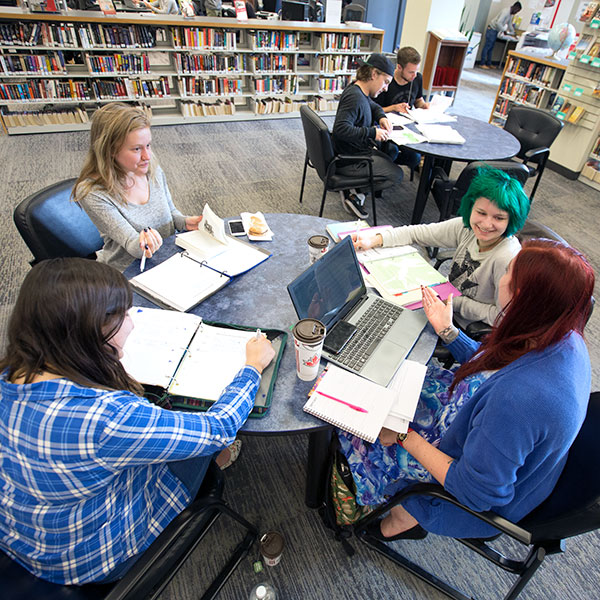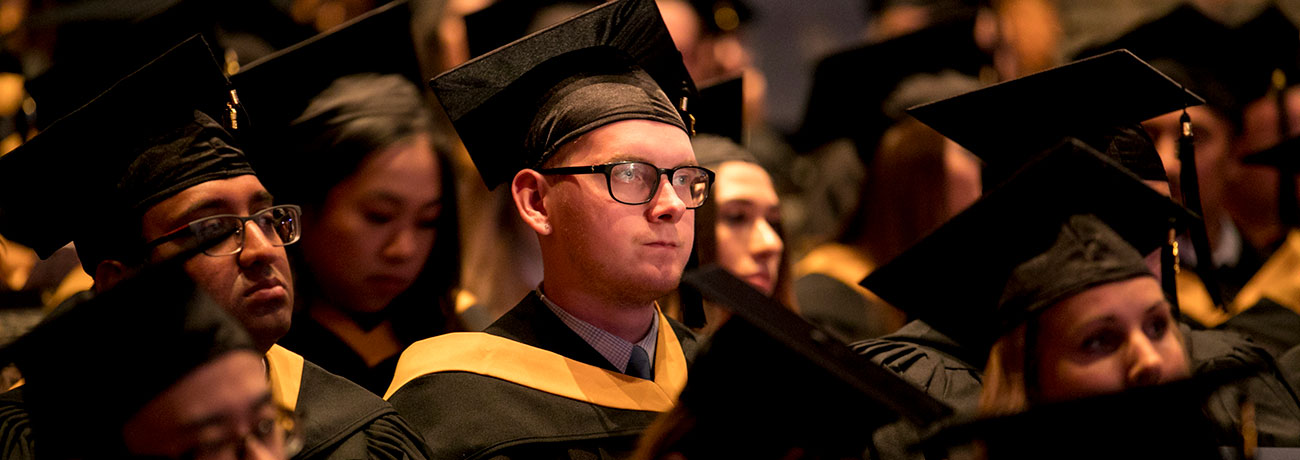On this page:
Overview
If you don't meet the requirements for our certificate, diploma, applied degree, and bachelor's degree programs, our Academic Upgrading program can help get you there.
Complete a variety of our high school equivalency courses depending on your academic goals and journey. We want you to feel comfortable here at SAIT and develop successful strategies for ongoing learning. Many adult learners use the Academic Upgrading program to upgrade high school courses.
All courses are Alberta high school equivalency courses (not Alberta Education credit courses) and are accepted by other Alberta post-secondary educational institutions for admission.
Check the current Alberta Transfer Guide published by The Alberta Council on Admissions and Transfer for a listing of all formalized transfer agreements among Alberta post-secondary institutions.
Please note that you cannot use the Academic Upgrading program to earn your high school diploma.
Why upgrade at SAIT
The benefits of taking Academic Upgrading courses at SAIT include:
- flexible class times where you can choose when and where to take your classes - during the day, evening, online, or even a combination of in-person and online through our blended option
- a supportive environment with access to free student services like tutoring, workshops to improve your learning strategies, assistance with writing, and counselling services.
We recommend you have access to a personal computer for your classes. Attendance and punctuality are directly related to academic success. Attending all your classes gives you a better chance of succeeding on assignments and tests.
Expand your learning with Open Studies
Are you interested in taking both Open Studies and Academic Upgrading courses? You can enroll in both simultaneously by applying to Open Studies first. Once you’ve been accepted, contact us at upgrading@sait.ca for assistance with registering for Academic Upgrading courses.
To succeed in the Academic Upgrading program, you need some key qualities and abilities, including:
- motivation and a strong desire to improve your academic skills and achieve your educational goals
- time management skills to balance coursework and other responsibilities
- self-discipline so you can stay focused while studying and completing assignments
- computer literacy
- being able to understand written materials in English
- study skills, including knowing how to take notes and prepare for exams
- effective communication skills, expressing your thoughts clearly verbally or in writing.
Courses
All SAIT upgrading courses are three (3) credits and 90 hours in length. Three or more classes per semester (9+ credits) are considered full-time studies.
All prerequisites are set at 60% except for Science 10 and SAIT courses, which are 50%.
| Course | Credits |
|---|---|
|
This course will develop the necessary science and related math skills to be successful in higher level physics and chemistry courses. Science Preparation includes the topics of technical measurement; energy flow in technological systems; energy and matter in chemical change; and properties in water. Pre-requisites:Manual Prerequisite
|
3 |
|
Topics in this course include: the biosphere; diversity of life; cell structure and function; photosynthesis and cellular respiration; and selected topics in human anatomy. This course is considered equivalent to Alberta Education's Biology 20. Pre-requisites:Manual Prerequisite
|
3 |
|
Topics in this course include: the nervous and endocrine systems; human reproduction and development; molecular and classical genetics; cell division; and populations and communities. This course is considered equivalent to Alberta Education's Biology 30. Pre-requisites:Manual Prerequisite
|
3 |
|
Topics in this course include mathematical, scientific, and laboratory standards for chemical measurement, elements and compound, introduction to atomic theory and structure, periodic table of the elements, simple inorganic compounds, acids and bases, chemical equations, gas and solution stoichiometry, and chemical bonding. This course is considered equivalent to Alberta Education's Chemistry 20. Pre-requisites:Manual Prerequisite
|
3 |
|
Topics in this course include mathematical, scientific, and laboratory standards for chemical measurement; introduction to organic chemistry; thermochemical changes, electrochemical changes; equilibrium of chemical systems; and acids and bases. This course is considered equivalent to Alberta Education's Chemistry 30. Pre-requisites:Manual Prerequisite
|
3 |
|
Students are introduced to a variety of literary forms, primary and secondary sources, and the associated referencing techniques. Written and oral assignments based on a variety of literary and visual materials are used to guide comprehension and critical analysis of studied texts. This course is considered equivalent to Alberta Education's English 20-1. Pre-requisites:Manual Prerequisite
|
3 |
|
Students explore a variety of literary and visual texts, and demonstrate an understanding of literature, primary and secondary material, and referencing techniques. Development and demonstration of skills in comprehension and critical analysis in written and oral assignments are required. This course is considered equivalent to Alberta Education's English 30-1. Pre-requisites:Manual Prerequisite
|
3 |
|
Students will study short stories, poems, a novel and a play in order to expand reading comprehension and writing skills. Paragraph and essay structure, as well as grammar and public speaking, will also be covered. This course is considered equivalent to Alberta Education's English 10-1. |
3 |
|
This course focuses on the preparation for further studies in mathematics. Topics include operations on whole and real numbers; fraction, decimal, and percent notation; geometry and measures; polynomials; and equations and inequalities. |
3 |
|
Math 162 continues to develop the topics of expressions and equations through an investigation of exponential and logarithmic functions as well as rational expressions and equations. Among other topics, students are also introduced to the concepts of probability, permutations and combinations. Pre-requisites:Manual Prerequisite
|
3 |
|
Math 180 is designed to provide students with a foundational understanding of algebra, number systems, measurement, trigonometry, relations and functions. Among other topics, students will be introduced to concepts involving the use of exponent laws, factoring of polynomials, the measurements of different variables, the analysis of right angle triangles, as well as graphical analysis as it applies to relations and functions. Pre-requisites:Manual Prerequisite
|
3 |
|
Math 181 further develops the concepts of algebra, trigonometry, and relations and functions. Among other topics, students will investigate radical expressions and equations, trigonometric ratios, sine and cosine laws, as well as general factoring techniques and quadratic expressions and equations. Pre-requisites:Manual Prerequisite
|
3 |
|
Math 182 explores concepts involving the composition and transformation of generalized functions, as well as polynomial operations. Students are exposed to the nature of exponential functions and their relationship with logarithms, as well as a detailed investigation of trigonometric functions and identities Pre-requisites:Manual Prerequisite
|
3 |
|
This course is an introduction of the fundamentals and theory of physics as it relates to technology. Problem solving is emphasized. Four units of study are covered: kinematics; dynamics; circular motion; work and energy; and oscillatory motion and mechanical waves. These units prepare students for further studies in physics. This course is considered equivalent to Alberta Education's Physics 20. Pre-requisites:Manual Prerequisite
|
3 |
|
This course completes the introduction of the fundamentals and theory of physics as it relates to technology. Problem solving is emphasized. Four units of study are covered: momentum and impulse; forces and fields; electromagnetic radiation; and atomic physics. These units prepare students for further studies in physics. This course is considered equivalent to Alberta Education's Physics 30. Pre-requisites:Manual Prerequisite
|
3 |
Progression
You must pass the prerequisite courses to progress through the program. Admission to SAIT and other post-secondary programs can be highly competitive. Grades higher than a minimal pass improve opportunities for admission to post-secondary programs.
See our course upgrading pathways.
Admission requirements
Once you have applied to the program, your transcripts will be reviewed by the Academic Upgrading team to determine the appropriate level of upgrading courses.
You may be required to complete placement tests. You must complete testing in all relevant subject areas if your transcripts are unavailable.
All applicants, including those educated in Canada, must demonstrate English language proficiency.
All applicants who were educated outside of Canada must demonstrate English language proficiency and provide proof they meet the program admission requirements outlined above with an international document assessment. Find accepted educational documents and assessment options.
SAIT may also accept courses completed at certain international post-secondary institutions.

English language proficiency
All applicants must demonstrate English language proficiency prior to admission, including students educated in Canada.

Placement testing
Once you have been confirmed in the Academic Upgrading Program, you are required to take a placement test to determine the proper placement level in upgrading courses for math and physics.
Transfer agreements
At SAIT, we have created transfer agreements with partner institutions to allow you to earn course credits toward your SAIT program based on your previously completed credentials.
Transfer Alberta search tool
Use the Transfer Alberta search tool to see all transfer agreements between Alberta post-secondary institutions (including those with the University of Calgary, Mount Royal University and Bow Valley College.)
Search transfer agreements in Alberta
There are no formal transfer agreements currently in place for this program.
Transfer options for graduates
When you have completed this program, you may continue your education at a partner post-secondary institution. These transfer agreements include partnerships within and/or outside of Canada.
Available intakes
Spring 2025
Start dates:
- Domestic students: Open
-
-
Application deadline: April 21, 2025
-
- International students: Open
-
-
Application deadline: April 21, 2025
-
Fall 2025
Start dates:
- Domestic students: Open
-
-
Application deadline: n/a
-
- International students: Open
-
-
Application deadline: n/a
-
Winter 2026
Start dates:
- Domestic students: Open
-
-
Application deadline: Oct. 24, 2025
-
- International students: Open
-
-
Application deadline: Sept. 26, 2025
-
Spring 2026
Start dates:
- Domestic students: Open
-
-
Application deadline: April 30, 2026
-
- International students: Open
-
-
Application deadline: March 27, 2026
-
Costs
2025/26 tuition and fees
The following costs are effective as of July 1, 2025.
The estimated cost of tuition and fees is based on the number of courses taken in a semester.
Domestic students
Books and supplies are approximately $150 to $200 per course.
MATH 181 and MATH 182 use Open Educational Resources (OERs), so no purchase is required. Some instructors may recommend additional supportive books in the form of math workbooks.
Consider waiting to purchase COMM 181 or COMM 182 textbooks until the first class so instructors can inform you of their preferences.
This is a bring-your-own-device program with a standard computer hardware and software requirement. See the specific requirements on our computers and laptops page.

Financial aid
You could potentially qualify for funding for your courses if you are out of high school for more than 12 consecutive months, are unemployed, working less than 20 hours per week, and/or earning a modest annual income, or are 18 years old and a Canadian citizen, permanent resident, or convention refugee.
Application process
Placement tests may be required to determine the proper placement level in academic upgrading courses for math and physics. Once you have applied to the program, your transcripts will be reviewed by the academic upgrading team to determine the appropriate level of upgrading courses.
Placement tests in other subject areas are also available if you are not meeting prerequisites through high school transcripts.
Learn more about Academic Upgrading placement testing.
Ready to apply?
Follow our step-by-step guide to submitting a successful application.
Communication during admission
Email is the primary source of communication during the admission process. Ensure your personal email account is managed appropriately to receive our emails, files and communications.
We recommend you add the upgrading@sait.ca domain to your safe senders' list, or you risk missing critical email messages.

Begin your application
Apply now using the online application portal.
Ensure you have a valid Visa or Mastercard to pay the non-refundable application fee of $120 for domestic applicants or $175 for international applicants.
Information sessions
Prepare for a strong start in your chosen program or get the details you need to decide your future path.
Our expert staff and faculty are ready to answer your questions and provide information about the following:
- What sets SAIT apart
- An introduction to the program and area of study
- Admission requirements
- Future career paths
- Information on the earning potential and graduate employment rates.
Contact us
Academic Upgrading
MC217, Stan Grad Centre
Drop-in hours
Mondays, Tuesdays & Thursdays: 10 am - 12 pm | 1 - 3 pm
Fridays: 10 am - 12 pm
International Student Advising
-
Phone - 403.284.8852
-
Email - international@sait.ca
Subscribe for updates
Your journey starts here! Sign up to get important updates on:
- Programs
- Application information
- Relevant news and events

Oki, Âba wathtech, Danit'ada, Tawnshi, Hello.
SAIT is located on the traditional territories of the Niitsitapi (Blackfoot) and the people of Treaty 7 which includes the Siksika, the Piikani, the Kainai, the Tsuut’ina and the Îyârhe Nakoda of Bearspaw, Chiniki and Goodstoney.
We are situated in an area the Blackfoot tribes traditionally called Moh’kinsstis, where the Bow River meets the Elbow River. We now call it the city of Calgary, which is also home to the Métis Nation of Alberta.
